Distributed Control Algorithm for DC Microgrid Using Higher-Order Multi-Agent System
Abstract
1. Introduction
- The dynamical model for the higher-order MAS is constructed by employing the DGU dynamics interfaced with the Buck converter, non-linear ZIP load, and dynamical RLC lines. The power consumption of the non-linear ZIP load depends on the voltage in the PCC. This combination of DC microgrid dynamics is unique.
- Communication networks gather information from neighboring agents and generate the consensus variable. This consensus variable is used to design the distributed controller to achieve voltage balance and current sharing among distributed non-linear ZIP loads and DGUs. The proposed distributed controller only uses the available state information of its neighboring agents.
- Steady-state stability for the DC microgrid is investigated, and necessary conditions are derived for the uniqueness of the equilibrium point. Furthermore, closed-loop stability is derived to verify the performance of the distributed control using a higher-order MAS, and conditions on control gains are presented.
2. Graph Theory for DC Microgrids
3. Voltage and Current Control Using High-Order MAS
4. Closed-Loop Stability for DC Microgrids
5. Results and Discussion
6. Conclusions
Author Contributions
Funding
Institutional Review Board Statement
Informed Consent Statement
Data Availability Statement
Acknowledgments
Conflicts of Interest
References
- Qazi, A.; Hussain, F.; Rahim, N.A.; Hardaker, G.; Alghazzawi, D.; Shaban, K.; Haruna, K. Towards Sustainable Energy: A Systematic Review of Renewable Energy Sources, Technologies, and Public Opinions. IEEE Access 2019, 7, 63837–63851. [Google Scholar] [CrossRef]
- Marks-Bielska, R.; Bielski, S.; Pik, K.; Kurowska, K. The Importance of Renewable Energy Sources in Poland’s Energy Mix. Energies 2020, 13, 4624. [Google Scholar] [CrossRef]
- Yahyaoui, I.; de la Peña, N. Energy Management Strategy for an Autonomous Hybrid Power Plant Destined to Supply Controllable Loads. Sensors 2022, 22, 357. [Google Scholar] [CrossRef] [PubMed]
- Rojas, D.; Muñoz, J.; Rivera, M.; Rohten, J. Review of Control Techniques in Microinverters. Sensors 2021, 21, 6486. [Google Scholar] [CrossRef] [PubMed]
- Rana, M.; Li, L. An Overview of Distributed Microgrid State Estimation and Control for Smart Grids. Sensors 2015, 15, 4302. [Google Scholar] [CrossRef]
- Nasr Esfahani, F.; Darwish, A.; Williams, B.W. Power Converter Topologies for Grid-Tied Solar Photovoltaic (PV) Powered Electric Vehicles (EVs) & mdash; A Comprehensive Review. Energies 2022, 15, 4648. [Google Scholar] [CrossRef]
- Alotaibi, S.; Darwish, A. Modular Multilevel Converters for Large-Scale Grid-Connected Photovoltaic Systems: A Review. Energies 2021, 14, 6213. [Google Scholar] [CrossRef]
- Omar, N.; Kumar Tiwari, A.; Seethalekshmi, K.; Anand Shrivastava, N. A Novel Controller Design for Small-Scale Islanded Microgrid Integrated with Electric Vehicle-Based Energy Storage Management. Int. Trans. Electr. Energy Syst. 2022, 2022, 1–19. [Google Scholar] [CrossRef]
- Mahmoud, M.; Azher Hussain, S.; Abido, M. Modeling and control of microgrid: An overview. J. Frankl. Inst. 2014, 351, 2822–2859. [Google Scholar] [CrossRef]
- Nicola, M.; Nicola, C.I. Comparative Performance Analysis of the DC-AC Converter Control System Based on Linear Robust or Nonlinear PCH Controllers and Reinforcement Learning Agent. Sensors 2022, 22, 9535. [Google Scholar] [CrossRef]
- Chen, M.; Suliang, M.; Haiyong, W.; Jianwen, W.; Yuan, J. Distributed Control Strategy for DC Microgrids of Photovoltaic Energy Storage Systems in Off-Grid Operation. Energies 2018, 11, 2637. [Google Scholar] [CrossRef]
- Reddy, G.; Kumar, Y.; Chakravarthi, M. Communication Technologies for Interoperable Smart Microgrids in Urban Energy Community: A Broad Review of the State of the Art, Challenges, and Research Perspectives. Sensors 2022, 22, 5881. [Google Scholar] [CrossRef]
- Dragičević, T.; Lu, X.; Vasquez, J.C.; Guerrero, J.M. DC Microgrids—Part I: A Review of Control Strategies and Stabilization Techniques. IEEE Trans. Power Electron. 2016, 31, 4876–4891. [Google Scholar] [CrossRef]
- Meng, L.; Shafiee, Q.; Trecate, G.F.; Karimi, H.; Fulwani, D.; Lu, X.; Guerrero, J.M. Review on Control of DC Microgrids and Multiple Microgrid Clusters. IEEE J. Emerg. Sel. Top. Power Electron. 2017, 5, 928–948. [Google Scholar] [CrossRef]
- Tayab, U.B.; Roslan, M.A.B.; Hwai, L.J.; Kashif, M. A review of droop control techniques for microgrid. Renew. Sustain. Energy Rev. 2017, 76, 717–727. [Google Scholar] [CrossRef]
- Szcześniak, P.; Grobelna, I.; Novak, M.; Nyman, U. Overview of Control Algorithm Verification Methods in Power Electronics Systems. Energies 2021, 14, 4360. [Google Scholar] [CrossRef]
- Naik, B.; Mehta, A. Sliding mode controller with modified sliding function for DC-DC Buck Converter. ISA Trans. 2017, 70, 279–287. [Google Scholar] [CrossRef]
- Jasim, A.; Jasim, B.; Bureš, V.; Mikulecký, P. A New Decentralized Robust Secondary Control for Smart Islanded Microgrids. Sensors 2022, 22, 8709. [Google Scholar] [CrossRef]
- Kantamneni, A.; Brown, L.E.; Parker, G.; Weaver, W.W. Survey of multi-agent systems for microgrid control. Eng. Appl. Artif. Intell. 2015, 45, 192–203. [Google Scholar] [CrossRef]
- Ahsan, M.; Ma, Q. Bipartite Containment Control of Multi-Agent Systems. In Proceedings of the 2019 IEEE/ASME International Conference on Advanced Intelligent Mechatronics (AIM), Hong Kong, China, 8–12 July 2019; pp. 895–900. [Google Scholar] [CrossRef]
- Hornik, T.; Zhong, Q.C. A Current-Control Strategy for Voltage-Source Inverters in Microgrids Based on H∞ and Repetitive Control. IEEE Trans. Power Electron. 2011, 26, 943–952. [Google Scholar] [CrossRef]
- Nguyen, T.L.; Guillo-Sansano, E.; Syed, M.; Nguyen, V.H.; Blair, S.; Reguera, L.; Tran, Q.T.; Caire, R.; Burt, G.; Gavriluta, C.; et al. Multi-Agent System with Plug and Play Feature for Distributed Secondary Control in Microgrid—Controller and Power Hardware-in-the-Loop Implementation. Energies 2018, 11, 3253. [Google Scholar] [CrossRef]
- Sahoo, S.K.; Sinha, A.K.; Kishore, N.K. Control Techniques in AC, DC, and Hybrid AC–DC Microgrid: A Review. IEEE J. Emerg. Sel. Top. Power Electron. 2018, 6, 738–759. [Google Scholar] [CrossRef]
- Nasirian, V.; Moayedi, S.; Davoudi, A.; Lewis, F.L. Distributed Cooperative Control of DC Microgrids. IEEE Trans. Power Electron. 2015, 30, 2288–2303. [Google Scholar] [CrossRef]
- Nahata, P.; Soloperto, R.; Tucci, M.; Martinelli, A.; Ferrari-Trecate, G. A passivity-based approach to voltage stabilization in DC microgrids with ZIP loads. Automatica 2020, 113, 108770. [Google Scholar] [CrossRef]
- Tucci, M.; Riverso, S.; Ferrari-Trecate, G. Line-Independent Plug-and-Play Controllers for Voltage Stabilization in DC Microgrids. IEEE Trans. Control. Syst. Technol. 2018, 26, 1115–1123. [Google Scholar] [CrossRef]
- Tucci, M.; Meng, L.; Guerrero, J.M.; Ferrari-Trecate, G. Stable current sharing and voltage balancing in DC microgrids: A consensus-based secondary control layer. Automatica 2018, 95, 1–13. [Google Scholar] [CrossRef]
- Zhao, J.; Dörfler, F. Distributed control and optimization in DC microgrids. Automatica 2015, 61, 18–26. [Google Scholar] [CrossRef]
- Trip, S.; Cucuzzella, M.; Cheng, X.; Scherpen, J. Distributed Averaging Control for Voltage Regulation and Current Sharing in DC Microgrids. IEEE Control Syst. Lett. 2019, 3, 174–179. [Google Scholar] [CrossRef]
- Lee, J.; Back, J. Robust Distributed Cooperative Controller for DC Microgrids with Heterogeneous Sources. Int. J. Control. Autom. Syst. 2021, 19, 736–744. [Google Scholar] [CrossRef]
- Mo, L.; Pan, T.; Guo, S.; Niu, Y. Distributed Coordination Control of First- and Second-Order Multiagent Systems with External Disturbances. Math. Probl. Eng. 2022, 2015, 7. [Google Scholar] [CrossRef]
- Tan, C.; Cui, Y.; Li, Y. Global Consensus of High-Order Discrete-Time Multi-Agent Systems with Communication Delay and Saturation Constraint. Sensors 2022, 22, 1007. [Google Scholar] [CrossRef] [PubMed]
- Zonetti, D.; Saoud, A.; Girard, A.; Fribourg, L. Decentralized monotonicity-based voltage control of DC microgrids with ZIP loads⁎⁎This work has been supported by Labex DigiCosme (project ANR-ll-LABEX-0045-DIGICOSME) operated by ANR as part of the program “Investissement dAvenir” Idex Paris Saclay (ANR-11-IDEX-0003-02). IFAC-PapersOnLine. In Proceedings of the 8th IFAC Workshop on Distributed Estimation and Control in Networked Systems NECSYS 2019, Chicago, IL, USA, 16–17 September 2019; Volume 52, pp. 139–144. [Google Scholar] [CrossRef]
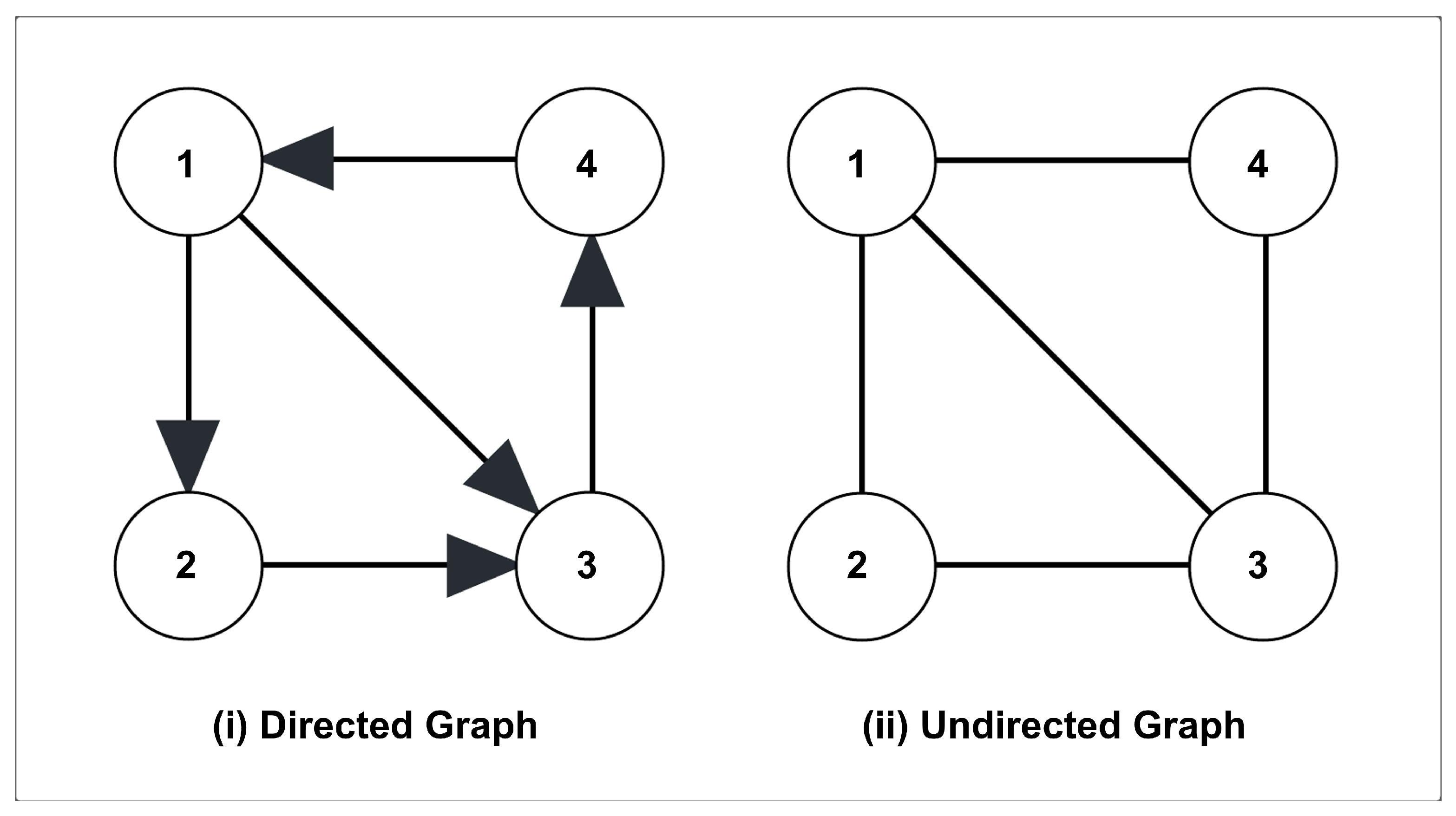
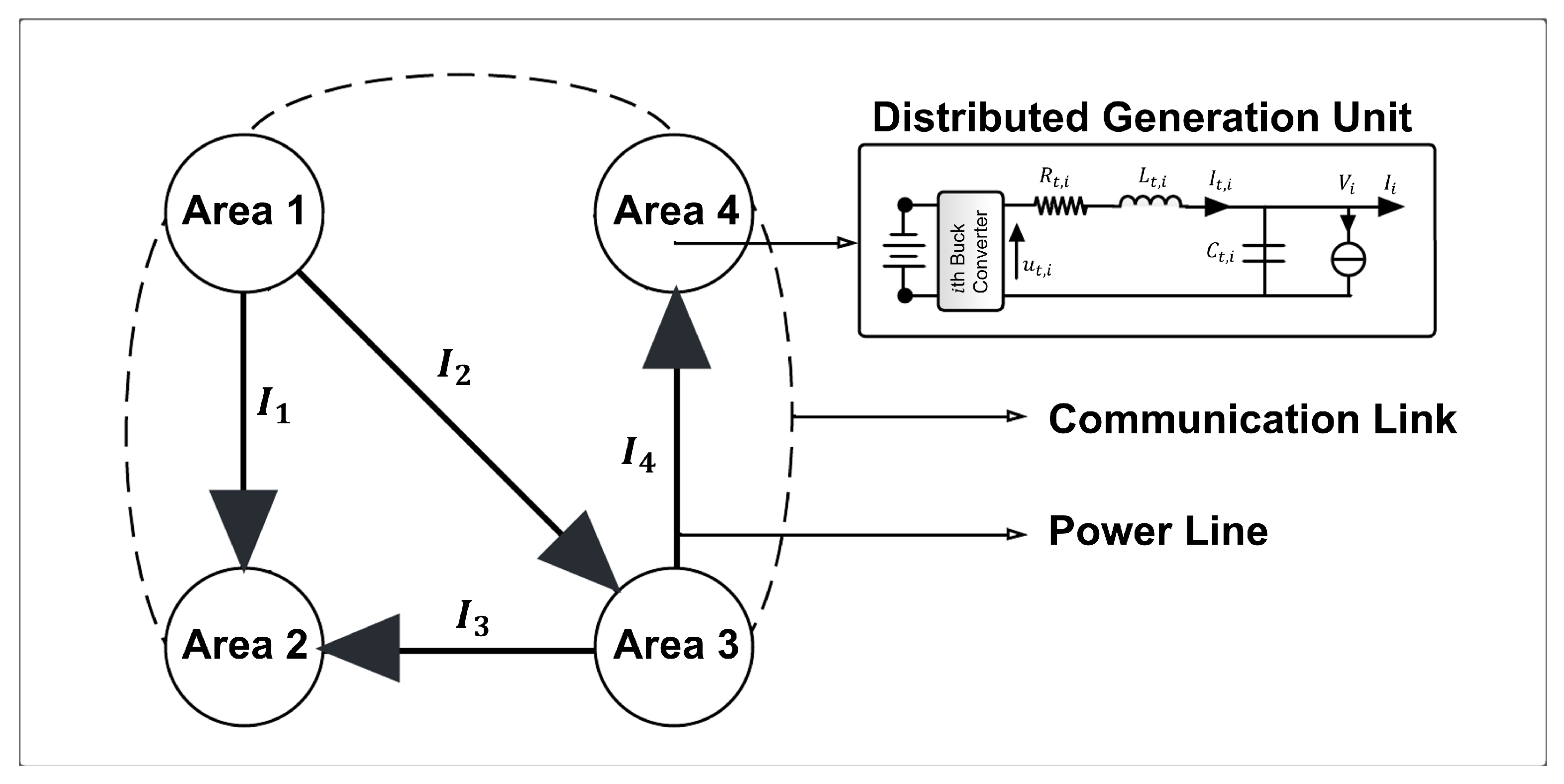

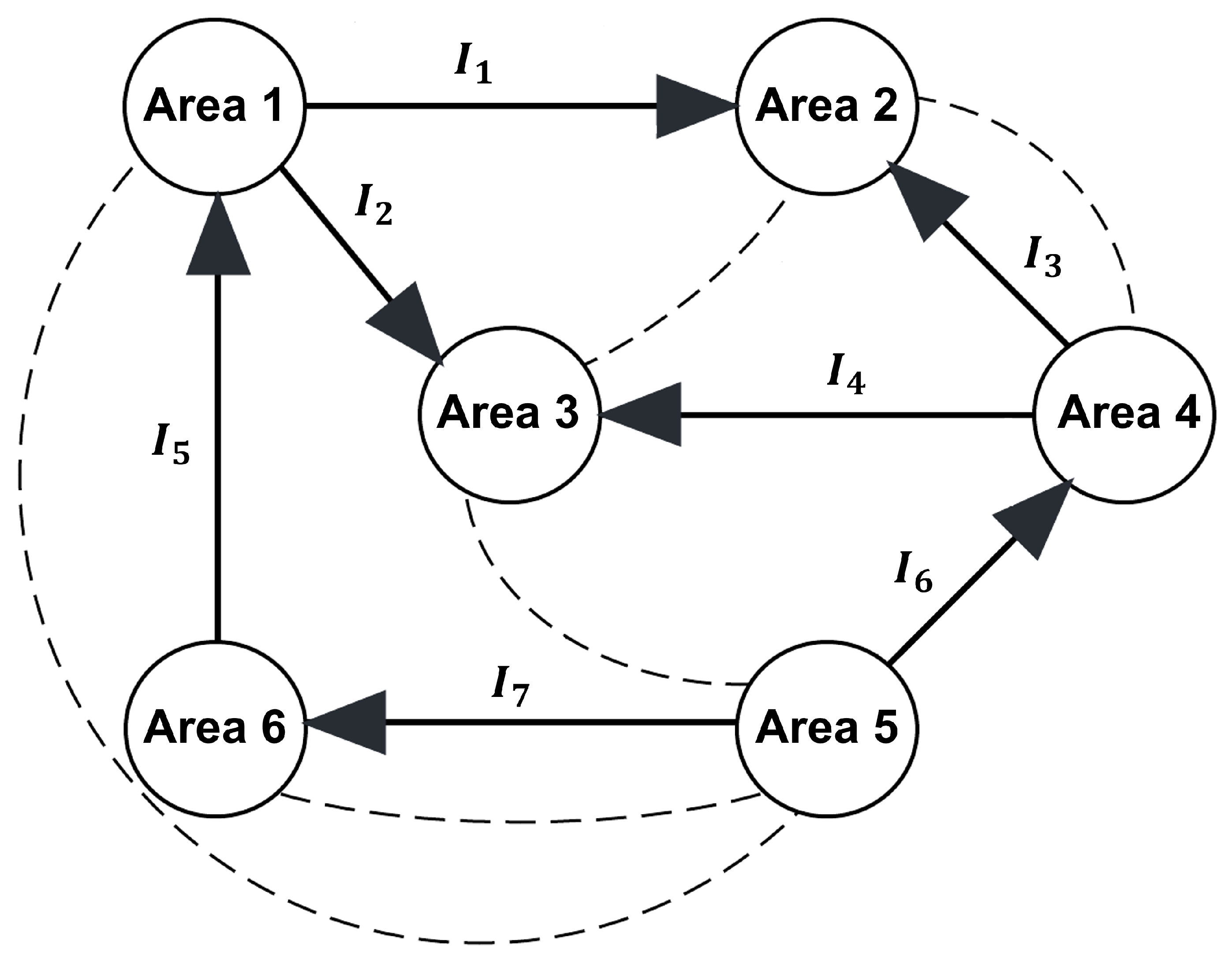
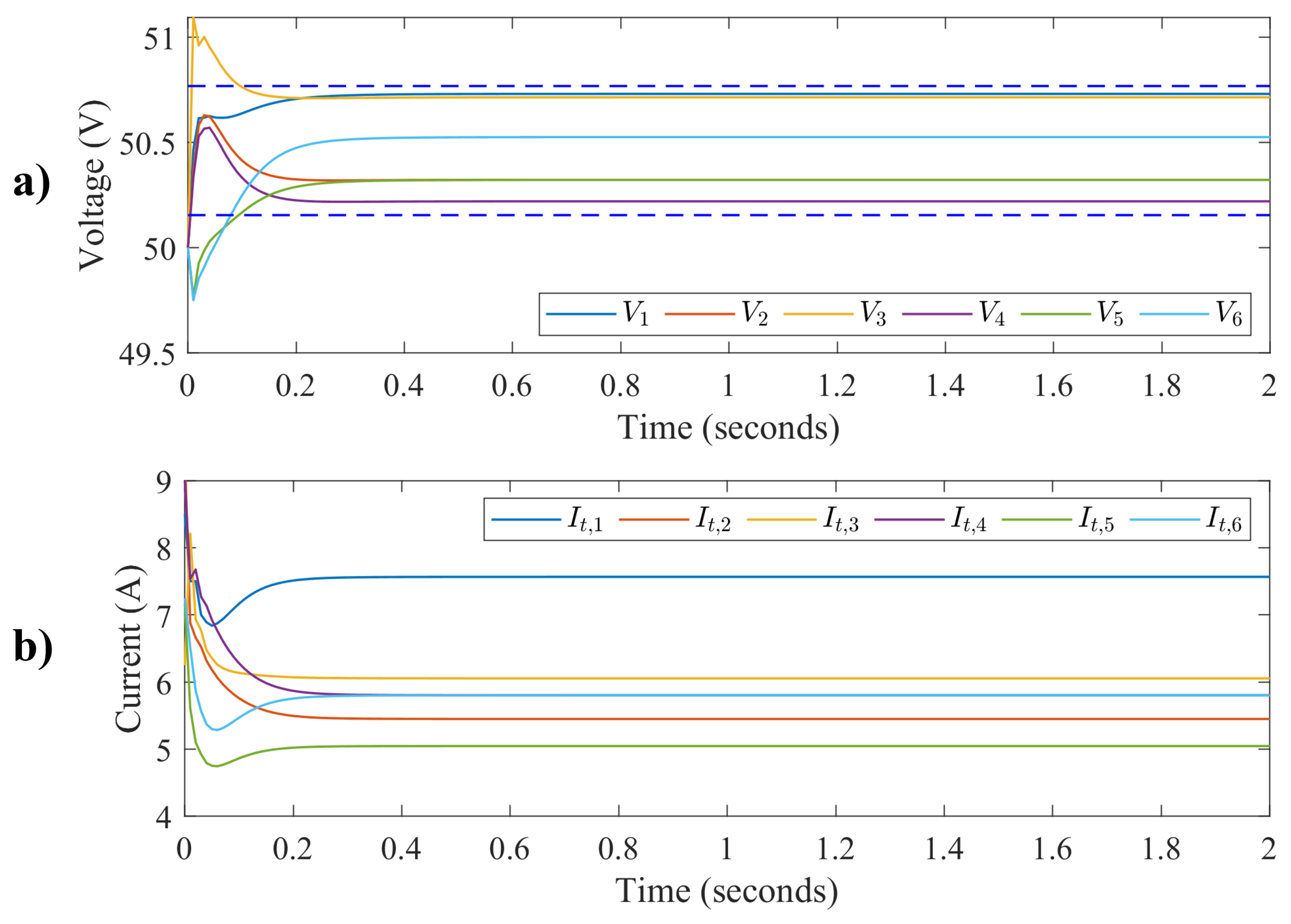
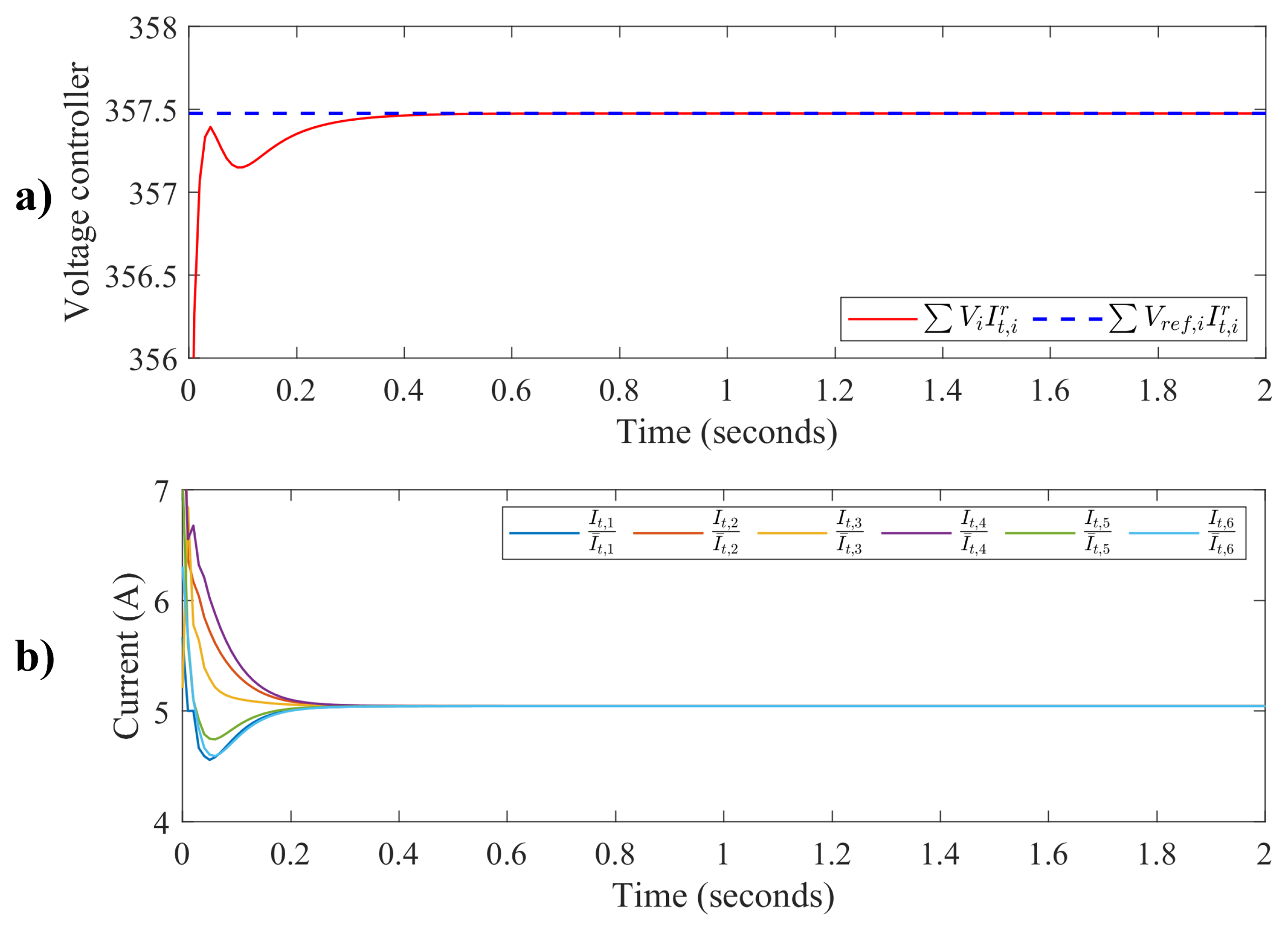



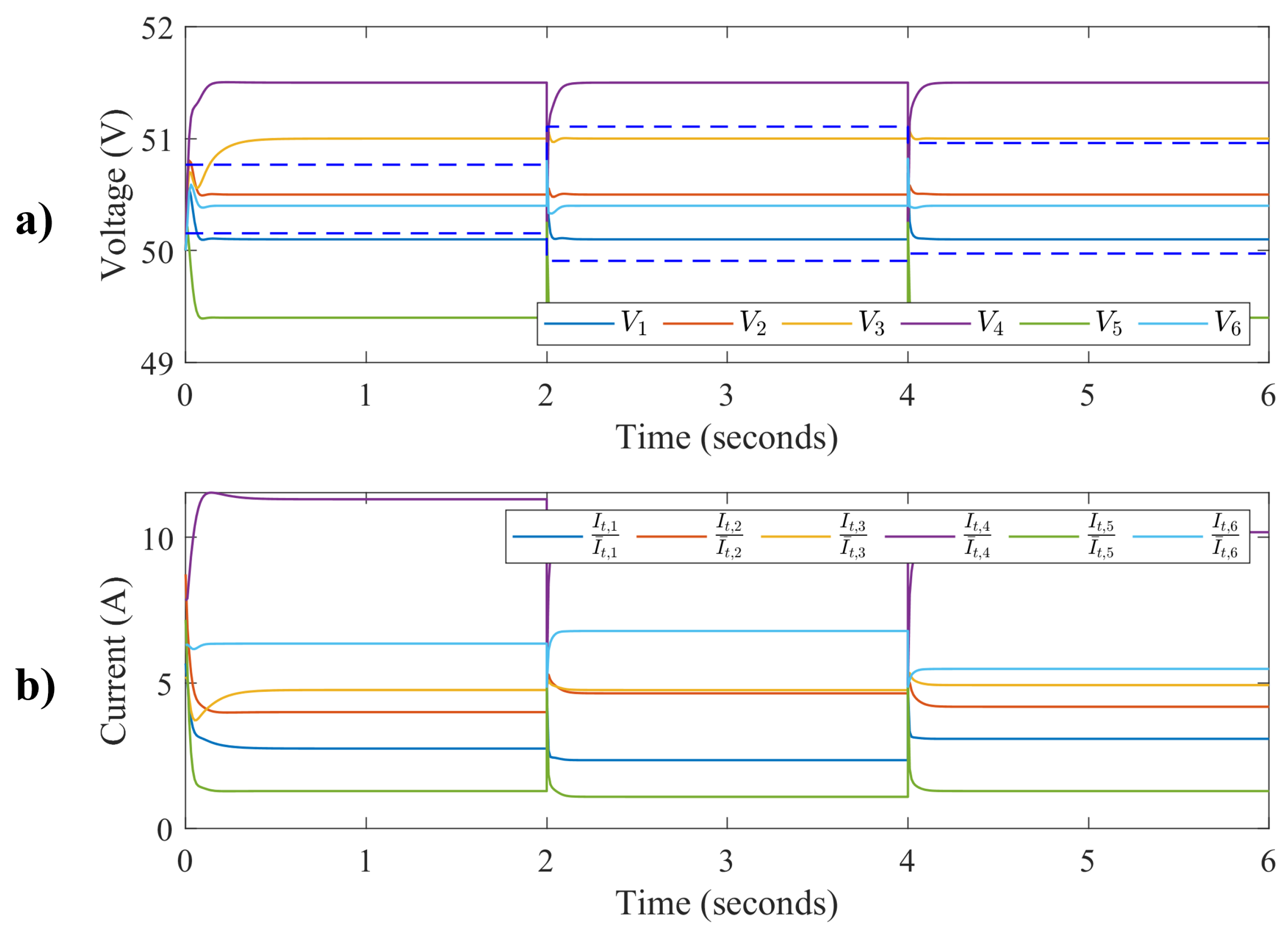
| Control Gains K for the Proposed Controller | ||||
|---|---|---|---|---|
| Agent | ||||
| −1 | 0.10 | 55.56 | −2 | |
| −1 | 0.15 | 75 | −2 | |
| −1 | 0.05 | 22.73 | −2 | |
| −1 | 0.25 | 83.3 | −2 | |
| −1 | 0.20 | 166.7 | −2 | |
| −1 | 0.30 | 120 | −2 | |
Disclaimer/Publisher’s Note: The statements, opinions and data contained in all publications are solely those of the individual author(s) and contributor(s) and not of MDPI and/or the editor(s). MDPI and/or the editor(s) disclaim responsibility for any injury to people or property resulting from any ideas, methods, instructions or products referred to in the content. |
© 2023 by the authors. Licensee MDPI, Basel, Switzerland. This article is an open access article distributed under the terms and conditions of the Creative Commons Attribution (CC BY) license (https://creativecommons.org/licenses/by/4.0/).
Share and Cite
Ahsan, M.; Rodriguez, J.; Abdelrahem, M. Distributed Control Algorithm for DC Microgrid Using Higher-Order Multi-Agent System. Sustainability 2023, 15, 8336. https://doi.org/10.3390/su15108336
Ahsan M, Rodriguez J, Abdelrahem M. Distributed Control Algorithm for DC Microgrid Using Higher-Order Multi-Agent System. Sustainability. 2023; 15(10):8336. https://doi.org/10.3390/su15108336
Chicago/Turabian StyleAhsan, Muhammad, Jose Rodriguez, and Mohamed Abdelrahem. 2023. "Distributed Control Algorithm for DC Microgrid Using Higher-Order Multi-Agent System" Sustainability 15, no. 10: 8336. https://doi.org/10.3390/su15108336
APA StyleAhsan, M., Rodriguez, J., & Abdelrahem, M. (2023). Distributed Control Algorithm for DC Microgrid Using Higher-Order Multi-Agent System. Sustainability, 15(10), 8336. https://doi.org/10.3390/su15108336








